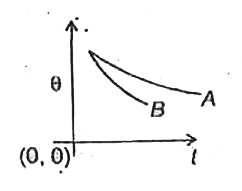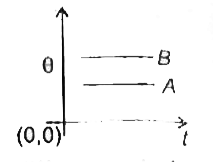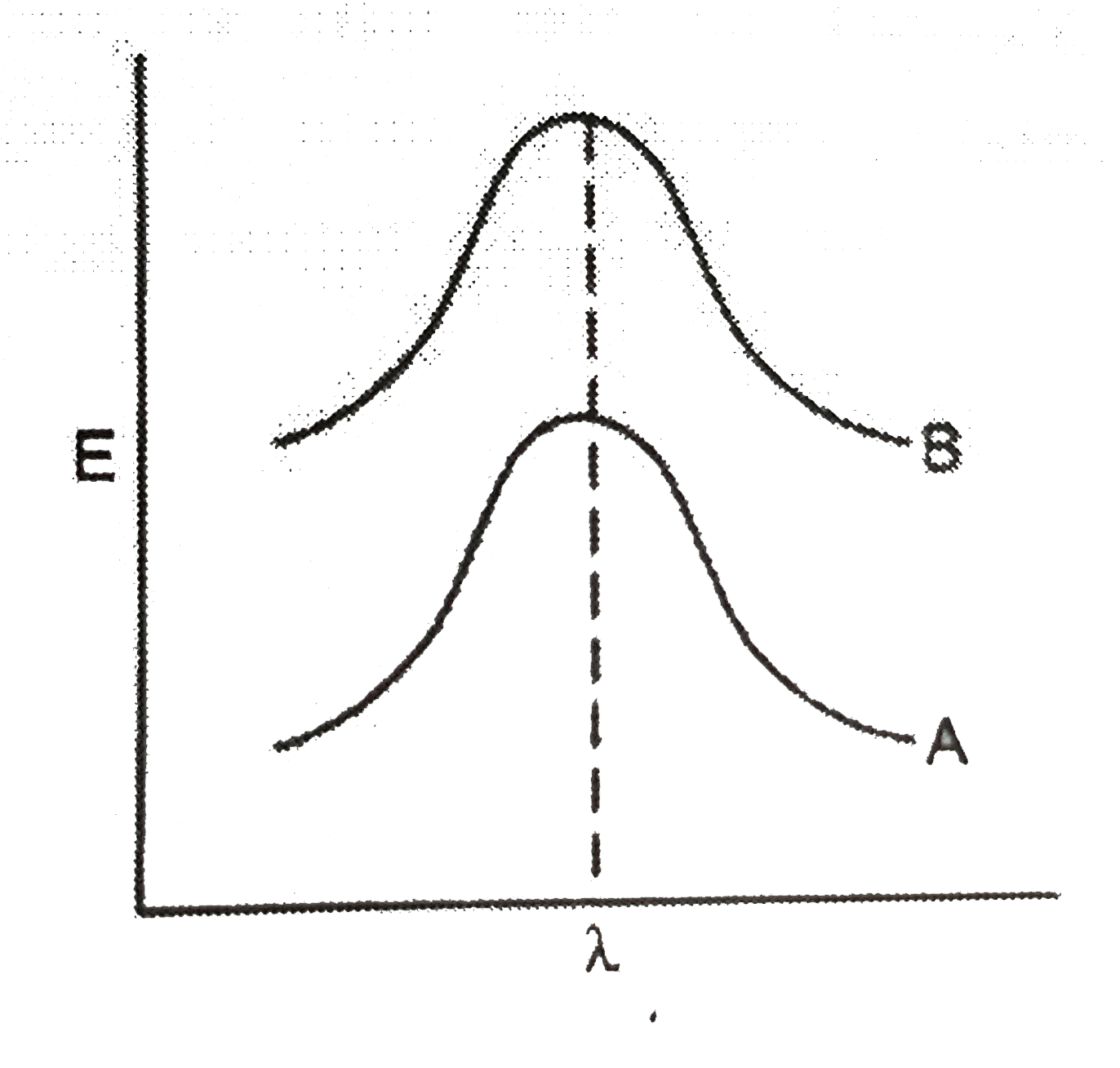Two bodies A and B of same mass, area and surface finish with specific heats and are allowed to cool for given temperature range. Temperature varies with time as




To solve the problem, we need to analyze the cooling rates of two bodies A and B based on their specific heats. Here's a step-by-step breakdown of the solution:
Step 1: Understand the Given Information
We have two bodies, A and B, with:
- Same mass (m)
- Same surface area (A)
- Same surface finish
- Specific heats: SA>SB
Step 2: Apply Newton's Law of Cooling
According to Newton's Law of Cooling, the rate of change of temperature of a body is proportional to the difference in temperature between the body and its surroundings. Mathematically, this can be expressed as:
dθdt∝−(θ−θambient)
Where:
- θ is the temperature of the body
- θambient is the ambient temperature
Step 3: Relate Cooling Rate to Specific Heat
The rate of cooling (i.e., the rate of change of temperature) is inversely proportional to the specific heat of the body. This means:
\frac{d\theta_A}{dt} < \frac{d\theta_B}{dt} \quad \text{(since S_A > S_B )}
This implies that body A, with a higher specific heat, will cool down more slowly than body B.
Step 4: Compare the Cooling Curves
At any given time t, since body A cools down slower than body B, we can conclude:
θA(t)>θB(t)
This means that at any instant during the cooling process, the temperature of body A will be greater than that of body B.
Step 5: Graphical Representation
When we plot the cooling curves of both bodies:
- The curve for body A will be above the curve for body B at all times.
- Both curves will start at the same initial temperature and will decrease over time, but the curve for A will decrease less steeply than that for B.
Conclusion
The correct option will show that the temperature of body A is always greater than that of body B during the cooling process.
Final Answer
The cooling curve of body A will always be above that of body B, confirming that θA>θB at all times during the cooling process.
---
We have two bodies, A and B, with:
- Same mass (m)
- Same surface area (A)
- Same surface finish
- Specific heats: SA>SB
According to Newton's Law of Cooling, the rate of change of temperature of a body is proportional to the difference in temperature between the body and its surroundings. Mathematically, this can be expressed as:
dθdt∝−(θ−θambient)
Where:
- θ is the temperature of the body
- θambient is the ambient temperature
The rate of cooling (i.e., the rate of change of temperature) is inversely proportional to the specific heat of the body. This means:
\frac{d\theta_A}{dt} < \frac{d\theta_B}{dt} \quad \text{(since S_A > S_B )}
This implies that body A, with a higher specific heat, will cool down more slowly than body B.
At any given time t, since body A cools down slower than body B, we can conclude:
θA(t)>θB(t)
This means that at any instant during the cooling process, the temperature of body A will be greater than that of body B.
When we plot the cooling curves of both bodies:
- The curve for body A will be above the curve for body B at all times.
- Both curves will start at the same initial temperature and will decrease over time, but the curve for A will decrease less steeply than that for B.
The correct option will show that the temperature of body A is always greater than that of body B during the cooling process.
The cooling curve of body A will always be above that of body B, confirming that θA>θB at all times during the cooling process.
Similar Questions
Avogadro’s number varies with temperature and pressure.(T/F)
View SolutionTwo metallic spheres S1andS2 are made of the same material and have got identical surface finish. The mass of S1 is thrice that of S2. Both the spheres are heated to the same high temperature and placed in the same room having lower temperature but are thermally insulated from each other. the ratio of the initial rate of cooling of S1 to that of S2 is
(a)13(b)1√3(c)√31(d)(13)13
View Solution
Knowledge Check
Radius of a shere is R density is d and specific heat is s, Is is heated and then allowed to cool Its rate of decrease of temperature will be proportional to .
ARdsB1/RdsC1/R2dsDR2dsThere are two spherical balls A and B of the same material with same surface, but the diameter of A is half that of B . If A and B are heated to the same temperature and then allowed to cool, then
ARate of cooling is same in bothBRate of cooling of A is four times that of BCRate of cooling of A is twice that of BDRate of cooling of A is 14 times that of B Two bodies A and B have the same surface area and mass the bodies have absolute temperaturesTA and TB emissivities ea and eb and specific heat capacities sA and sB. The intensity, E , of radiation near a given wavelength is shown plotted against the wavelength λ, of radiation for both the bodies. Which of the following is possible?ATA=TB,eA=eB,sA≠sBBTA=TB,eA≠eB,sA=sBCTA≠TB,eA=eB,sA=sBDTA≠TB,eA=eB,sA≠sB
Two bodies A and B have the same surface area and mass the bodies have absolute temperaturesTA and TB emissivities ea and eb and specific heat capacities sA and sB. The intensity, E , of radiation near a given wavelength is shown plotted against the wavelength λ, of radiation for both the bodies. Which of the following is possible?ATA=TB,eA=eB,sA≠sBBTA=TB,eA≠eB,sA=sBCTA≠TB,eA=eB,sA=sBDTA≠TB,eA=eB,sA≠sB
Two balls of same material and same surface finish have their diameters in the ratio 1:2. They are heated to the same temperature and are left in a room to cool by radiation, then the initial rate of loss of heat
View SolutionWhen two bodies ofmasses m1 and m2 with specific heats s1 and s2 at absolute temperatures T10 and T20(T10>T20) are connected by a rod of length l and cross sectional area A with thermal conductivity k. Find the temperature difference of the bodies after time t. Neglect any heat loss due to radiation at any surface..

View SolutionTwo bodies A and B are of same mass and same amount of heat is given to both of them .
If the temperature of A increases more than that of B because of heat addition ,then
View SolutionTwo metallic spheres S1andS2 are mode of the same material and have got identical surface finish. The mass of S1 is thrice that of S2. Both the spheres are heated to the same high temperature and placed in the same room having lower temperature but are thermally insulted from each other. The ratio of the initial rate of coiling of S1 to that of S2 is
View SolutionTwo metallic sphere A and B are made of same material and have got identical surface finish. The mass of sphere A is four times that of B. Both the spheres are heated to the same temperature and placed in a room having lower temperature but thermally insulated from each other.
View Solution
